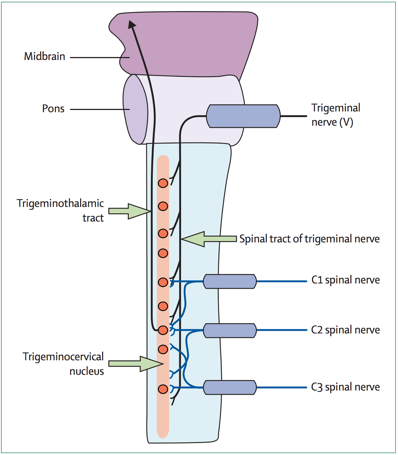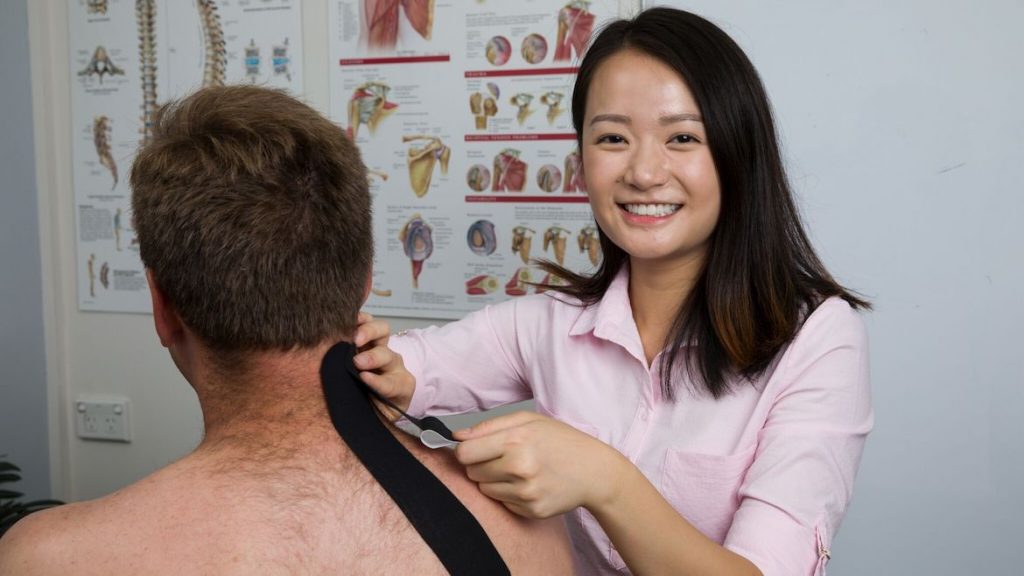What is cervicogenic headache?
By Chiropractor Dr Coco Ho
Have you ever experienced chronic headache on one side of your skull, aggravated by neck movement?
Did you also have pain travelling behind your eye?
If the answer is yes, you may have been experiencing a cervicogenic headache.
By definition, ‘cervico-‘ means neck, and ‘-genic’ means origin. It is a secondary headache, which arises from the neck and radiates to different parts of skull, auricular (ears) and orbital (eyes) areas. It can be very painful and impair your quality of life significantly.
What causes cervicogenic headache?
 A cervicogenic headache occurs due to the irritation of some of the nerves around the cervical spine. In the upper cervical spinal cord, there is a cluster of neural cells called the trigeminocervical nucleus (see image) where sensory fibres of the trigeminal nerve and upper cervical nerves (C1, C2, and C3) are integrated.
A cervicogenic headache occurs due to the irritation of some of the nerves around the cervical spine. In the upper cervical spinal cord, there is a cluster of neural cells called the trigeminocervical nucleus (see image) where sensory fibres of the trigeminal nerve and upper cervical nerves (C1, C2, and C3) are integrated.
Nerve signals are then sent fromtrigeminocervical nucleus to the brain where the signals are interpreted, and appropriate response is executed.
So what causes the headache?
A cervicogenic headache may occur if the sensory receptors of those nerves are irritated by noxious stimulus- a stimulus that wasn’t supposed to happen, but happened anyway!
Possible causes of irritation of those nerves include:
• Postural strain (repetitive micro stress)
• Trauma such as whiplash injury or sports injury
• Facet dysfunction
• Degeneration of cervical spine (Arthritis)
• Disc prolapse
• Poor sleeping position
As each nerve supplies different sensory area of the face and head, the area of pain may differ depending on the nerve that is involved. The headache is usually involved with one side and may radiate from the neck and to the front of the head/ behind the eye. Different pain patterns are shown below. For example, if the nerves are irritated at the spinal level of C1-2, you’re more likely to experience your headache behind the eye, around the ear, and in the neck.
What other signs and symptoms are presented with cervicogenic headache?
A cervicogenic headache may be caused by or accompanied by:
• Pain exacerbated by neck movement
• Tenderness around upper 3 cervical spine joints
• Decreased range of motion
• Weak deep neck flexors, causing forward head carriage, and
• Increased tone of trapezius, levator scapulae and sub-occipital extensor muscles
How common is cervicogenic headache?
Cervicogenic headaches are an often under-diagnosed and over-looked cause of headaches. The prevalence of cervicogenic headache with clinical criteria has been estimated to be 1% – 4.1%. In the general population, and it has been found that 17.5% of patients who have a severe headache are ultimately diagnosed with a cervicogenic headache. In the case of whiplash (as may occur in a car accident) the prevalence is as high as 53%!
Cervicogenic headaches typically cause pain at the back of the head. However, location may be differ depending on which nerve is (are) involved. The pain may refer to the top of the skull or to the forehead or temple. It may also be behind the eyes.
Criteria of Diagnosis
Like any ache or pain, the key to successful management and treatment is having an accurate diagnosis. Clinical criteria are used for diagnosis of cervicogenic headache incoude:
1. Symptoms and signs of neck involvement .
- A headache similar to the usually occurring one:
- By neck movement and/or sustained awkward head positioning, and/or:
- By external pressure over the upper neck or occipital region on the symptomatic side
- Reduced of range of motion in the neck
- One sided neck, shoulder, or arm pain of a rather vague nature or, non-radicular occasionally, arm pain of a radicular nature.
2. Confirmatory evidence by diagnostic anaesthetic blockade
(which is usually not practical to undertake in a clinical setting, however may be of value if conservative treatment options are not working).
3. One sided of the head pain, without side shift
Head pain characteristics:
- Moderate-severe, non-throbbing pain, usually starting in the neck.
- Episodes of varying duration, or
- Fluctuating, continuous pain
How can a chiropractor help with cervicogenic headache?
The role of chiropractor is to detect potential musculoskeletal causes and correct the dysfunction and biomechanics in the upper cervical spine. An appropriate treatment plan may then be directed with various treatment options.
Evidence-based treatment options for chiropractor include:
• Chiropractic spinal manipulation: Recommended twice per week over 3 weeks
• Joint mobilisation: Recommended 8-12 treatments over 6 weeks. Choice of low or high velocity techniques is based on initial and progression of patient’s symptoms
• Exercise: Deep neck flexor exercise to strengthen the muscular structures around cervical spine is recommended for twice per day over 6weeks.
Prior to any such undertaking however, your Chiropractor will carry-out a thorough examination and history taking to exclude other potential causes of your headaches.
With a correct diagnosis, close monitoring, and effective treatments- many cervicogenic sufferers have experienced relief with Chiropractic care.
Next: An interview with Chiropractor Dr Coco Ho…
or
Next: Meet our Chiropractic team…
References:
1. Bogduk, N. and Govind, J., 2009. Cervicogenic headache: an assessment of the evidence on clinical diagnosis, invasive tests, and treatment. The Lancet Neurology, 8(10), pp.959-968.
2. Chaibi, A. and Russell, M.B., 2012. Manual therapies for cervicogenic headache: a systematic review. The journal of headache and pain, 13(5), pp.351-359.
3. Dunning, J.R., Butts, R., Mourad, F., Young, I., Fernandez-de-las Peñas, C., Hagins, M., Stanislawski, T., Donley, J., Buck, D., Hooks, T.R. and Cleland, J.A., 2016. Upper cervical and upper thoracic manipulation versus mobilization and exercise in patients with cervicogenic headache: a multi-center randomized clinical trial. BMC musculoskeletal disorders, 17(1), p.64.
4. Jull, G., Trott, P., Potter, H., Zito, G., Niere, K., Shirley, D., Emberson, J., Marschner, I. and Richardson, C., 2002. A randomized controlled trial of exercise and manipulative therapy for cervicogenic headache. Spine, 27(17), pp.1835-1843.
5. Nilsson N, Christensen HW, Hartvigsen J. The effect of spinal manipulation in the treatment of cervicogenic headache. J Manipulative Physiol Ther. Jun 1997;20(5):326-30.


